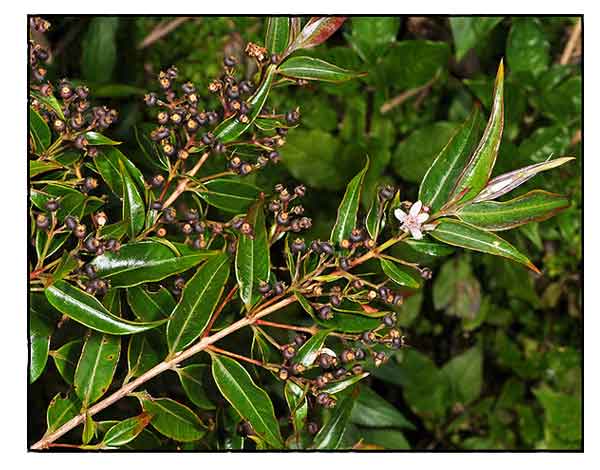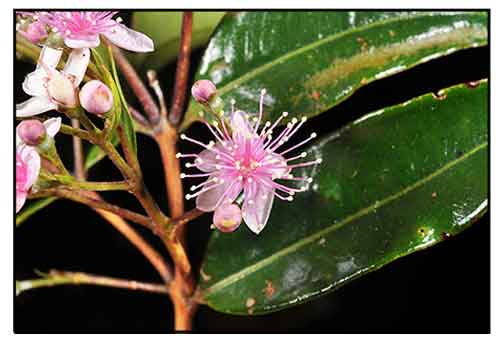
Family • Myrtaceae
Patalsik
Decaspermum parviflorum (Lam.) A.J.Scott
SILKY MYRTLE
Wu ban zi lian shu
| Scientific names | Common names |
| Decaspermum parviflorum (Lam.) A.J.Scott | Patalsik (Tagalog) |
| Eugenia parviflora Lam. | Silky myrtle (Engl.) |
| Myrtus parviflora (Lam.) Spreng. | |
| Nelitris parviflora (Lam.) Blume | |
| Accepted Infraspecifics | |
| Decaspermum parviflorum subsp. parviflorum | |
| Decaspermum parviflorum subsp. quadripartitum J.Parn. & NicLugh | |
| Decaspermum parviflorum (Lam.) Scott is an accepted species. KEW: Plants of the World Online | |
| Some compilations and sites consider Decaspermum parviflorum and Decaspermum fruiticosum J.R. Forst & G. Forst as synonyms, some list them as separate species. This site deals with the issue as separate species until evidence definitely indicates otherwise. | |
| Silky myrtle as common name is shared by Decaspermum parviflorum and D. humile. | |
| Patalsik as local common name is also shared by Decaspermum fruticosum and D. parviflorum. | |
| Other vernacular names |
| CHINA: Wu ban zi lian shu. |
| INDONESIA: Andolok pakal, Kayu demang, Tembagan. |
| MYANMAR: Taung-thabye. |
| THAILAND: Khee tai, Krim. |
Gen info Distribution
Properties Studies Availability |
March 2023
![]()
 |
| PHOTOS / ILLUSTRATIONS |
| IMAGE SOURCE: Photo: Myrtaceae : Decaspermum parviflorum / Fruiting and flowering twig / Copyright © 2013 by P B Pelser & J F Barcelona (contact: [email protected]) [ref. DOL77183] / Non-Commercial Use / click on image to go to source page / Phytoimages.siu.edu |
| OTHER IMAGE SOURCE: Photo: Myrtaceae : Decaspermum parviflorum / Floower / Copyright © 2016 by P B Pelser & J F Barcelona (contact: [email protected]) [ref. DOL113374] / Non-Commercial Use / click on image to go to source page / Phytoimages.siu.edu |
Additional
Sources and Suggested Readings |
α•(5) |
DOI: It is not uncommon for links on studies/sources to change. Copying and pasting the information on the search window or using the DOI (if available) will often redirect to the new link page. (Citing and Using a (DOI) Digital Object Identifier) |
| List of Understudied Philippine Medicinal Plants |
α•(5) |
 |


 Constituents
Constituents